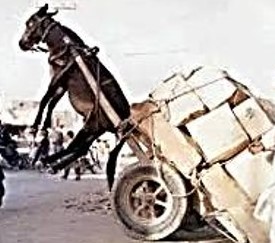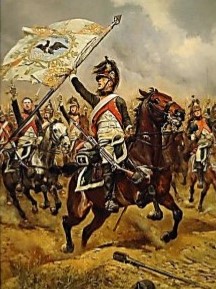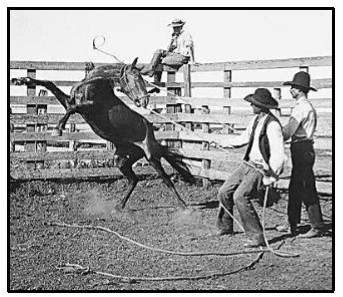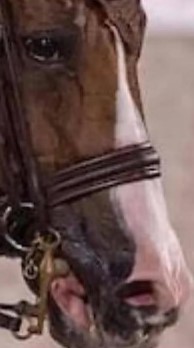Equi-note 10 Ignoring the Matching Principle Aggravates Disharmony

Source: Bilalham senior pakwheeler 2004 nkc
Equi-note 10
Ignoring the Matching Principle aggravates disharmony
What does this mean?
We can understand disharmony in several ways.
In the case of a horse and rider it is very different from the working conditions shown above, where the owners have made the wagon too heavy.
But it does show the effects of an imbalance, which lies at the heart of a mismatch.
In previous posts the aspect of a physical and mental or emotional mismatch were shown. Naturally, this is based on the integration of horse and rider.
However, it can also mean that even when Inputs are matched harmoniously, other factors may intervene. Which makes achieving the harmony even more difficult. This is because there is another group of important items we need to consider.
These are the Outputs
This is a group where there is a whole range of possible outcomes. From good to bad.
The bad group is often accompanied by negativity or conflict. Regrettably!
Because they show working with disharmony. They are the opposite of working with good harmony, as was described in the previous post. https://Equi-note #9 Working With Good Harmony. They are often the consequence of training methods many of which have harmful side-effects.
We need to bear in mind that the horse has been used by humans for thousands of years. In many ways. And even today the horse still fulfills a broad range of vital functions for society’s benefit, apart from the sporting events which are the object of this blog. These include transport, cavalry and local policing and agriculture. Historically, the demands of these types of job involved extreme situations, many of them highly conflictive.
Cavalry

Source: “Le Trophée” Édouard Detaille 1898, Battle of Jena 1806; pd
Agriculture

Source: wikimedia.org. cc
Transportation

Source: engraving by Edwin Lanseer 1870 “Old Tired Pack Horse”, pd
Equinamity’s view is that Ignoring the Matching Principle aggravates
disharmony
And probably many horse owners and riders are likely to agree, even if silently.
Such owners and riders may well be caught in a trap with a charismatic and highly assertive trainer. This means that they cannot question their methods. The author has seen numerous trainers whose verbal flair and powerful personalities are greater than their training and riding skills.
There is an important additional aspect to this observation which must be made. This criticizm does not mean that they have not been successful. Many are, or have been, in their particular skill area.
However, the point being made is that it is possible to achieve similar or even superior results more effectively. This is because there are better and more humane ways to achieve the desired results. So, obviously, this leads to the next question.
What are these new techniques?
Subsequent posts will specifically illustrate many new techniques where for the most part better outcomes can be achieved but without the negatives.
It is undeniable that many training methods currently used have benefitted both horses and their owners. Otherwise, these practises would not have lasted for as long as they have. However, one of their primary objectives which is usually left unspoken, is to ensure the trainer’s next pay check.
This invariably encourages short-cuts.
What are some of these training methods?
Many books have been written on the subject of training methods. It is not the intention of this blog to enter into detail about them. However, it is important to mention several of the most significant.
One of them involves the reliance on excessively long periods in each day’s training. Another is the endless repetition of the same exercises. These become especially negative if they are either pointless, overly ambitious or exhausting. Another includes excessive violence and the extreme reliance on artificial aids.
Sooner or later the effects of these methods will show up. The horse will make this clear via one or more of the following symptoms:
- Fatigue/lack of energy
- Stress/nervousness
- Loss of weight/condition/health
- Decline in quality of work
- Disobedience
- Injury/carelessness
Because these Outputs are so significant, some of their underlying causes need to be looked at carefully.
What are some of the underlying causes of problem Outputs?
Several reasons contribute to this situation. Historically, access to training horses has been the preserve of a small percent of the population. Thus, training methods tended to be transferred within closely-knit communities, such as the cavalry (up to mid-20th century), users of horse-drawn vehicles and agriculture. More recently clusters have emerged around pony clubs, specialized sports groups, etc.
As a result, training methods have been frequently been passed from one generation to another. This has contributed to the slow pace of change. Thus, negative methods have managed to survive. As well as many good methods.
There is another important reason why many old-fashioned ways are still used. This is because they are often part of the “demonstration” of the trainer’s or rider’s “extensive” skills. Such “exhibitions” are typically made to impress the owners of the horses or the students they are training.
These methods need to be reviewed because they are extensively used by
professional riders and trainers
And they do not use them on unusual occasions, but as their standard training methods. As a result, they are responsible for the outcomes, which range from to good to bad.
Often this arises because, as has been stated, above ignoring the Matching Principle aggravates disharmony. And some matches may be made on opportunistic grounds rather than “best fit”.
There is also the genetic consideration. Overall, horses’ genetics have changed little for centuries (intelligence, size, conformation, etc.). Although certain breeds of horse have shown substantial development.
As a consequence, methods for training have tended to reflect that slow pace of change. What alterations have occurred have tended to be introduced very slowly.
Also training methods have been generally been passed from one generation to another. This has contributed to the slow pace of change. Thus, negative methods have managed to survive. It goes without saying that good methods have also been maintained or expanded.
In defense of professionals, it also needs to be said that often they, both riders and trainers, are under a great deal of pressure. Many of them have to train or ride 10-15 horses each per day. This limits the amount of time they can spend on each horse to broaden its education.
Why is it that confrontational measures are so often used to “train” the
horse?
There are a number of reasons.
Several of them have been mentioned above. High up the list is the almost universal human attitude towards learning (carrot, stick, repetition, memorization, impatience, etc.). Another is that many equestrian traditions of a classical nature are regarded with awe. And physical violence was regarded for most of history as acceptable, even through much of the 20th century.
Another important reason is that to many observers, such measures have an air of authority about them.
Because these measures look dramatic, the rider/trainer acquires a “greater
legitimacy” in front of his/her audience.
However, the key point being made in this blog is that this approach has serious shortcomings. Since Ignoring the Matching Principle aggravates disharmony.
The trainer and rider’s objective is to “wow” the involved parties (most importantly, the client). The client must be satisfied with the outcome. But this reaction lasts only for a given moment and longer-term consequences are probably pushed aside.
With short-term results secured, many professional riders and trainers will not feel the need to search for better methods. In some cases, many of them don’t even believe that better alternatives exist. As a result, roughness has become their standard approach.
It also needs to be stated that financial pressures on riders and trainers mean that short-term results are required. They cannot spend extra time, even if a superior alternative exists. Even though it might offer an eventual better competitive result and a longer life for the horse.
Equinamity’s view is that the creation of fear, stress and exhaustion should
never be allowed to be promoted as an “ideal” method.
This by no means is meant to criticize the occasional need for discipline, both mental and physical. These are essential for success. The question is the level and methods of their use.
Such an approach soon becomes part of the overall welfare issue. And there is ample proof of the damage which it causes.
If so, what is the evidence? The evidence is plain to see, in stables, in showgrounds, in racetracks and other venues.
The next photo will take us back into a distant time and place. However, it is well known that even today similar practises exist.

Mustang

Source: Erwin Evans Smith ca. 1907, pd
Many knowledgeable researchers, academics and horse lovers have explored this subject in considerable depth, as the next quote confirms:
“Horse-training techniques that may defy the principles of learning theory and compromise welfare”; by Andrew N. McLean Australian Equine Behaviour Centre, Clonbinane, Broadford, Victoria, Australia; Paul D. McGreevy Faculty of Veterinary Science, University of Sydney, New South Wales, Australia July–August 2010; https://doi.org/10.1016/j.jveb.2010.04.002.
“This review considers some contemporary training and restraining techniques that may lead to confusion or abuse in ridden and non ridden horses. As competitive equestrian sports boom, the welfare of the horse is under increasing scrutiny. The current focus on hyperflexion of the neck in dressage warm-up has exposed the problems with relying on subjective opinions when attempting to safeguard horse welfare.
The techniques and devices described here are discussed in terms of their potential to inhibit learning, create confusion, or compromise welfare. They include hyperflexion of the neck (including what is commonly referred to as rollkur), inducing confusion by using one signal for two or more different responses, simultaneous and contradictory signals or pressures, rapping, gingering, soring, sedation and nerve blocks, electric shock collars, horse walkers, water deprivation, apparatus intended to increase control or alter the horse’s head and neck position, certain nosebands, whips and spurs, and finally hobbles”
The following examples reveal how Ignoring the Matching Principle
aggravates disharmony
Deficiencies are shown by:
The many promising horses that are physically broken down. This situation happens not only to older horses, but to horses that are still young. It happens very frequently to horses that are at the beginning of their careers. There are extensive statistics available as to the average (shortened) productive life spans of racehorses (±3-4 years) and European dressage horses (±5-7 years)
The distressing scenes of excessive “discipline” by riders and trainers often witnessed in the show arenas and warm-up areas.
The extensive abuse to which horses are subject during training. These situations occur while working at home (extensively witnessed by the author). It happens far from the public gaze and so it is hard both to quantify and to sanction. One Nordic trainer was recently sanctioned at a show since horses that he was training suffered mouth injuries. The positive effect that such an approach can have is that the following year, no such injuries were found from horses trained by this individual.
Horses subject to strict discipline often reveal their stress via health problems, such as colics, ulcers and weight loss.
Frequent displays of resistance to many forms of discipline or work by an unhappy horse. This may be revealed at any time, when working, in the stables and in general handling.
Horse owners and trainers using such methods are likely to have experienced varying types and levels of disobedience, including physical injury to themselves.
An example of a stressed horse is shown next.

Source: nkc
The above examples bring us to the second principle:
Principle #2 Ignoring the Matching Principle aggravates disharmony
As mentioned in a previous post, there is also the question of personalities. This is not only the horse but also of the rider. Some of these will be looked at next.